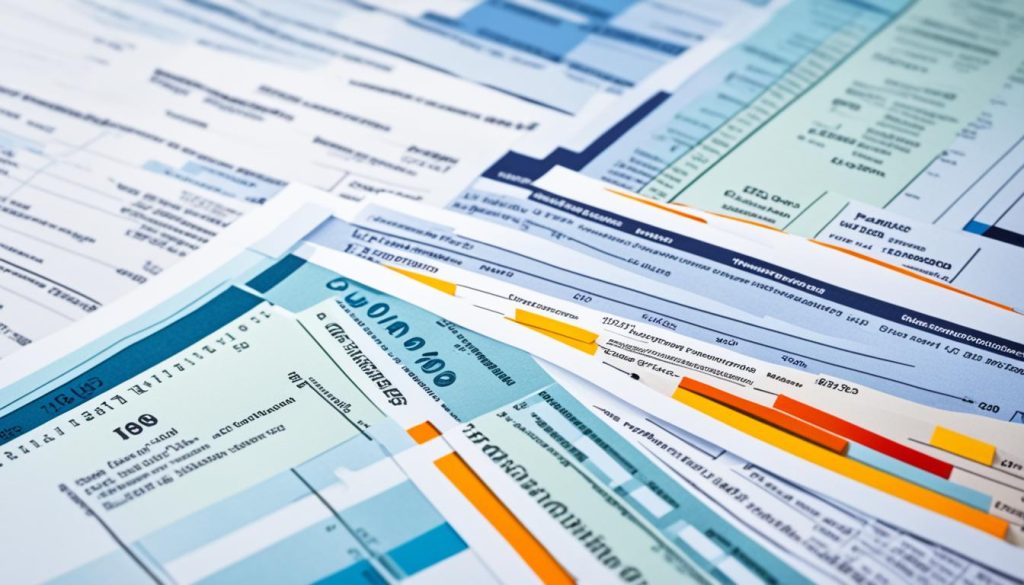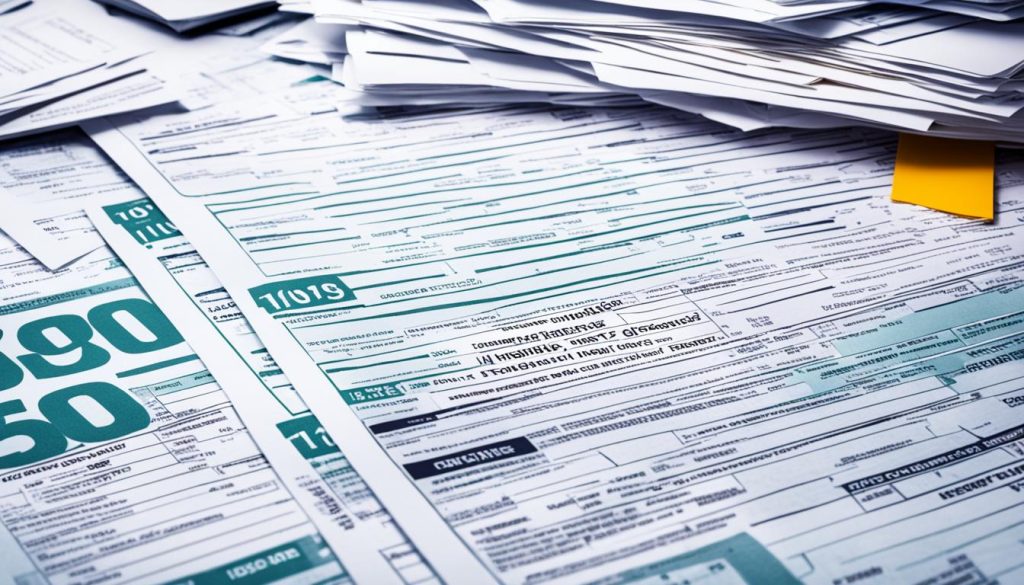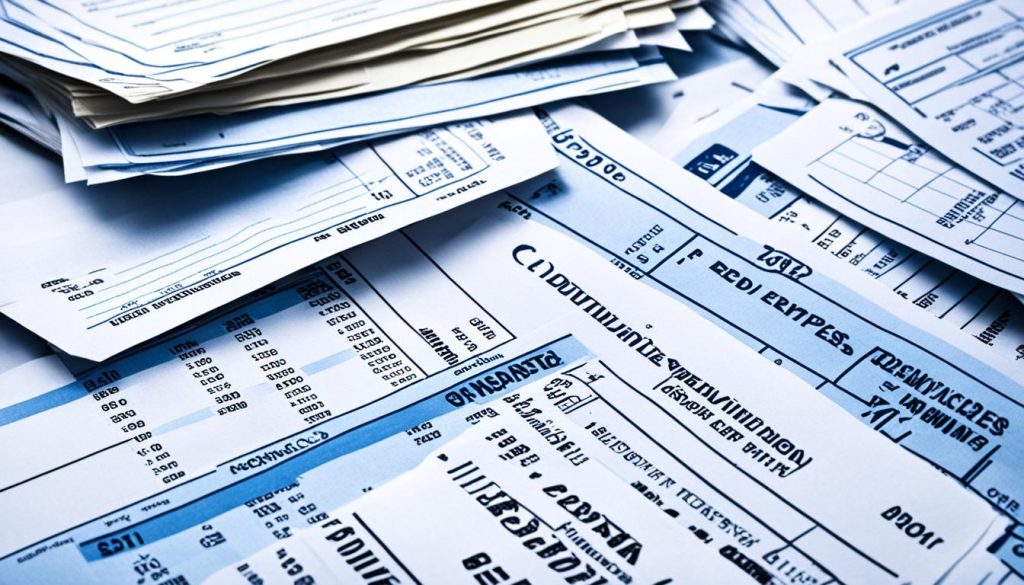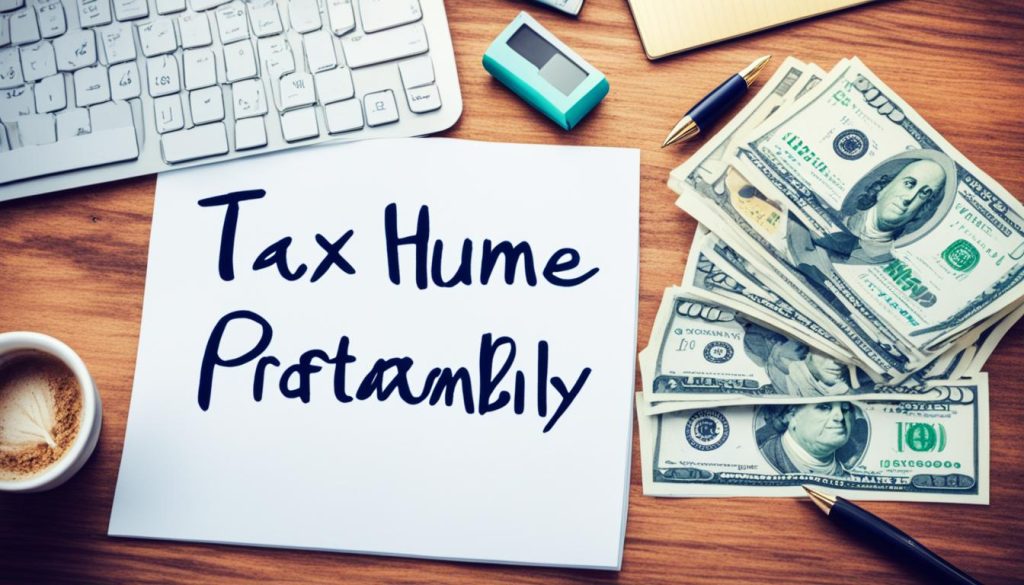Have you joined the millions boosting their income with a side hustle? The gig economy brings great chances but also tax issues not to be overlooked. Do you understand what taxes you owe and what you can deduct for your side job?
Dealing with self-employed taxes and deductions is key for your side gig. Whether you’re blogging, driving for a rideshare service, or selling on Pinterest, tax rules change. Let’s look at essential tips to manage your side hustle earnings and reduce your tax load.
Being a blogger and Pinterest lover, I’ve seen how combining different jobs can boost income. By blogging and using Pinterest, I’ve upped my pay and secured my financial future. This piece will look at the key tax points for these gigs and give you advice to understand the gig economy’s tax aspects better.
Tax Tips for Side Hustlers
If you work for yourself, it’s important to know how taxes affect your extra work. You are responsible for paying taxes that include funds for Social Security and Medicare. The self-employment tax rate is 15.3%, covering 12.4% for Social Security and 2.9% for Medicare. It applies to the money you actually keep from your side job. Keep careful records of what you spend to help lower how much you pay in taxes.
Reporting Side Hustle Income to the IRS
To the IRS, you must report what you earn from your side work. This goes on either Schedule C if you’re your own boss, or Schedule E for rental or royalty payments. Even if you’re paid in cash without a 1099, you still must tell the IRS about it. If you don’t report, you could face penalties. So, keeping good records is a must.
Maximizing Deductions for Business Expenses
You get to cut down on how much tax you pay by deducting certain work costs. Things like mileage for your car, the costs of your home office, and other expenses can help lower your tax bill. Make sure you keep records of all these deductible expenses to increase your deductions and ease your tax load.
| Expense Type | Deductibility |
|---|---|
| Vehicle Mileage | Deductible at the standard mileage rate |
| Home Office | Deductible if the space is used exclusively and regularly for business purposes |
| Office Supplies | Deductible as ordinary and necessary business expenses |
| Marketing and Advertising | Deductible as ordinary and necessary business expenses |
As your side hustle brings in more money, you may owe more in taxes. This could mean needing to pay hundreds or thousands of dollars extra. It’s smart to save 20-35% of your earnings to cover your taxes. This can help you avoid paying fees for not paying enough tax throughout the year.
Also, if you earn more than $1,000 from your side work, you might need to pay taxes four times a year. This is instead of waiting until the year’s end. Having a separate bank account for your side work expenses can make it easier to keep track of your finances and make sure you’re paying your taxes on time.
Because figuring out taxes for side jobs can be hard, it’s a good idea to get help. A tax professional, like a certified public accountant (CPA) or an enrolled agent, can guide you. They can make sure you don’t miss any tax breaks and that you’re following all the tax rules right.
Federal Income Tax Obligations
If you’re running a side hustle, knowing your tax duties is key. The IRS wants you to report any net income of $400 or more from it. This is true even if you didn’t get a 1099 form for that work. Not telling the IRS about this income could lead to penalties.
Reporting Thresholds and Filing Requirements
Let’s say your side job makes $400 or more in net income. Then, you need to report it on your taxes, with or without a 1099 from the payer. Not doing so can land you in trouble with the IRS. They see it as a serious issue if the tax you owe is over 10% of the correct tax, or $5,000 for folks.
Penalties for Underreporting Income
Getting your side hustle income numbers wrong can cost you. The IRS might hit you with up to a 20% penalty for paying less tax than you should. So, keep careful records and report all earnings. It helps you steer clear of these fines.

Tracking and Reporting Cash Payments
If you’re getting paid in cash for a side hustle and no 1099 form comes your way, you still must let the IRS know. If you don’t, you could face penalties and fines. It’s key to keep good track of the money you make and spend. This helps you get the most out of any deductions and correctly show your earnings.
Importance of Record-Keeping
Keeping excellent records for your side gig is a big deal. You should record all cash payments, and keep a list of business costs. Tools like MileIQ make it easier to manage cash payments and income tax reports. When you’re organized and careful with your record-keeping, you can increase the deductions you can get and follow the rules set by the IRS.
Handling Multiple 1099 Forms
If you earn money from different places, you’ll get multiple 1099 forms. These show income from various jobs, rentals, or online sales. It’s key to combine all your incomes for tax reporting. Then, you put the total on your Form 1040.
Consolidating Income Streams
It can be tough to manage multiple 1099 forms, but it’s vital. By merging all your incomes, you ensure correct self-employment tax payment. This also helps lower your tax expense.

Don’t forget to report income you don’t get a 1099 for. The IRS needs to know about all your earnings to avoid penalties. Keep things tidy, maintain good records, and get help from a tax expert if it helps. This way, you can handle multiple 1099 forms accurately.
Quarterly Estimated Tax Payments
If you’re self-employed, you need to pay taxes every quarter. This is instead of having them taken out of a paycheck. These payments keep you current on taxes and stop you from getting fined.
Deadlines and Payment Methods
You must pay taxes by April 15, June 15, September 15, and January 15. How you pay doesn’t matter – online, by phone, mail, or through the IRS’s EFTPS. Being on top of these payments is key to avoid penalties and meeting your tax duties.
Deductible Business Expenses
If you work for yourself, you can lower your taxes by deducting certain business costs. These costs include things you really need for your work, travel expenses, and if you use part of your home for work.
Ordinary and Necessary Expenses
You can deduct business expenses like office supplies and costs for learning more about your work. It’s important to keep good records of what you spend. This helps you save more on your taxes.
Vehicle Mileage and Transportation Costs
Using your car for work means you can deduct some costs. This is for miles you drive for work or for business-related travel.
Home Office Deduction
If you work from home in a specific area, you might get a home office deduction. It lets you deduct part of your home’s costs if it’s for your work.

Keeping clear records of your expenses is key to lowering your taxes. By using deductions for what you truly need and your work travel, you can make your business more profitable. This ensures you follow all tax rules.
Classifying Side Hustles as Hobbies
When you’re doing a side hustle, it might feel like a hobby. But knowing the IRS guidelines for hobby income is key. It affects how you handle taxes on what you earn from your side work.
IRS Guidelines for Hobby Income
The IRS labels something as a hobby if the main goal isn’t making money. They look at various points to decide if what you’re doing is a hobby or a business. These include:
- Your intent to make a profit from the activity
- The time and effort you put into the activity
- Your success in similar activities in the past
- the way you carry on the activity, such as keeping accurate records and having a separate business account
- Whether the activity generates consistent profits year after year
If the IRS sees your side work as a hobby, you might not pay self-employment tax on its income. But, you still must report what you make and can only claim expenses up to that amount.
Thinking about whether your side hustle is a hobby or a business is smart. It can lead to more tax deductions. Plus, it keeps you on the right side of tax rules and laws.

Evaluating Side Hustle Profitability
Starting a side hustle is exciting but risky. It’s important to think about how much money you make after paying taxes. This way, you’ll know if your effort is really paying off. This helps you set the right prices, control costs, and plan your moves well.
Calculating Net Income and Tax Burden
To truly see if your side hustle is worth it, figure out your net income. This is what you earn after taking out your expenses. Don’t forget about the taxes. Your side business can boost your tax bill by quite a bit each year.
Experts say you should save 20–35% of what you earn for taxes. This avoids a big tax bill later. And if you owe more than $1,000 after deductions, you’ll need to pay taxes during the year.
Thinking about your net income and taxes helps you make smarter choices for your hustle. You can adjust what you charge and spend to keep it profitable

It’s smart to track what you earn and spend for your side job. Having a special bank account just for your business makes this easy. Also, keep a simple system to save receipts and records for taxes.
If dealing with side job taxes feels too hard, get help. A tax pro can show you the way. They can find you more deductions and lower your tax bill.
State and Local Tax Implications
Besides federal taxes, you might owe state and local taxes on your side gig money. The rules for state taxes and how to file them can differ by where you live. Be sure to check your local laws to make sure you’re doing everything right.
State Income Tax Rates and Filing Requirements
In states like Maryland, Massachusetts, and several others, you might need to report your gig work if you made over $600. Forgetting to do this could mean you’re not paying enough taxes. Then, you might owe more, plus a penalty. Knowing the rules in your state is very important.
| State | 1099-K Threshold |
|---|---|
| Maryland | $600 |
| Massachusetts | $600 |
| Vermont | $600 |
| Virginia | $600 |
| District of Columbia | $600 |
| North Carolina | $600 |
| Montana | $600 |
Self-Employment Tax Calculations
If you’re self-employed, you pay for Social Security and Medicare on your own. This is your self-employment tax. It’s a part of the net income you make on your side job, after expense deductions.
Social Security and Medicare Contributions
In 2023, you’ll pay a 15.3% self-employment tax. Social Security takes up 12.4%, and Medicare takes 2.9%. So, 15.3% from your net income goes to these taxes.
First, find your net self-employment income. Subtract your business deductions from your total income. Then, apply the 15.3% tax rate to this amount to know what you owe.
You should pay estimated taxes four times a year to avoid penalties by the IRS. Keeping up with your tax duties makes sure you follow the rules and avoid problems at tax time.
Record-Keeping Strategies
Maintaining detailed records is key for side hustlers. It helps reduce taxes and follow IRS rules. Good record-keeping strategies make tax time smoother and lower audit risks.
Expense Tracking Apps and Tools
Use expense tracking apps and tools to simplify recording business costs. Apps like Mint, QuickBooks Self-Employed, and FreshBooks are easy to use. They help categorize and track expenses, providing helpful tax insights.
Maintaining Receipts and Invoices
It’s critical to keep physical receipts and invoices too. This proof is vital if the IRS ever checks your taxes. It helps validate deductible costs and ensures you save as much on taxes as possible.
With strong record-keeping strategies, good use of expense tracking apps and tools, and careful receipt and invoice storage, tax preparation becomes easier. Plus, you can make the most of the tax advantages for side hustles.
Filing Tax Forms for Side Hustles
Understanding tax requirements for a side hustle can seem hard. But knowing the right tax forms is key. It helps you follow the rules and get the most deductions. For your side job taxes, you should fill out forms like Schedule C and Schedule SE.
Schedule C and Schedule SE
Schedule C is for reporting your side business’s income and costs. It lets you subtract business expenses reducing what you owe. You must do Schedule SE too. It figures your self-employment tax that includes Social Security and Medicare.
Form 1099-NEC and Form 1099-K
Your side hustle type decides if you get forms like 1099-NEC or 1099-K. These show your earnings. Make sure to note this income in your tax filing. Not doing so can lead to fines. Remember to keep track of any 1099 forms you get.
Blogging and Pinterest Side Hustles
Blogging and Pinterest are great side hustles. They offer low costs to start and no big risks. Through blogging, you can make money from ads, affiliate links, and selling digital stuff. Pinterest helps by sending more people to your blog or shop, making you more money.
Low Start-Up Costs and Risk-Free Business Models
Starting a blog or using Pinterest doesn’t take much money. You can look professional with very little investment. This makes blogging side hustles and Pinterest businesses doable for anyone. They let you try things out without risking a lot of money.
Building a Side Hustle Stack with Blogging and Pinterest
To earn more and have money coming from different places, try both blogging and Pinterest. Good blog content and Pinterest go well together. They bring more people to your stuff and give you more ways to make money. This side hustle stack can steady your income and help with taxes too.
Blogging and Pinterest are smart choices for extra money or starting a business. By using both, you can make a good income. You also get the flexibility and benefits of a business that grows with you.
Tax Considerations for Rideshare Drivers
Driving for companies like Uber or Lyft brings unique tax responsibilities. It’s key to track mileage and vehicle expenses closely. This allows you to lower your taxable income and manage your taxes better.
Mileage Tracking and Vehicle Expenses
Keeping precise mileage records is vital. It helps you claim the standard mileage deduction. This means you can subtract a certain amount for each mile you drive for work. You should also track other vehicle expenses like gas and maintenance that are for your job.
Keeping good records could save you a lot on taxes. Use a mileage tracking app to make it easier. This also keeps your records safe in case the tax man comes asking.
By managing your mileage and expenses, you can cut how much you owe in taxes. It’s a good idea to get tax help. A pro or software like TurboTax can guide you on tax breaks for rideshare drivers.
Tax Planning with a Professional
If your taxes are tricky or you want to get the most back, a pro can help. A certified public accountant (CPA) or an enrolled agent knows their stuff. They’re great at showing you tax tricks and making sure you follow the rules.
If you make money in different ways or spend a lot on your job, they’re your go-to people. They check your finances, give smart tax tips, and help lower what you owe. With their help, handling your side earnings at tax time becomes a lot easier.
Looking into professional tax planning services? TurboTax offers live help and a thorough self-filing option. They look for all the deductions and credits you can get to cut your tax bill.

